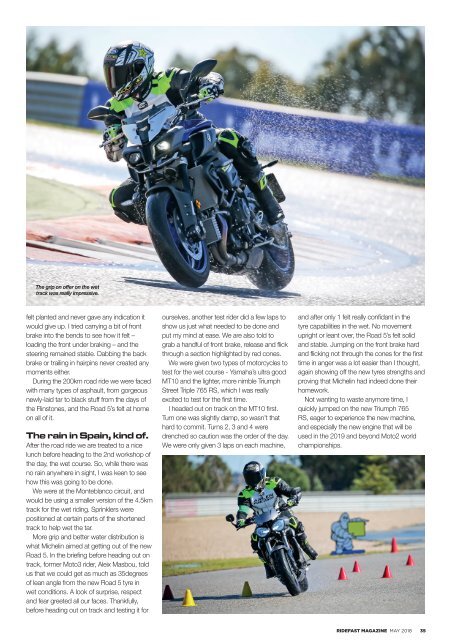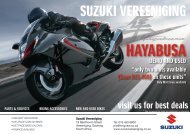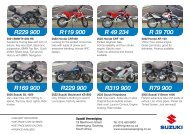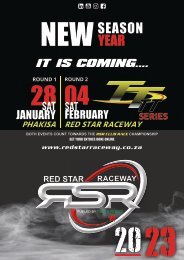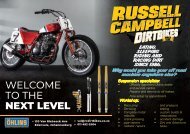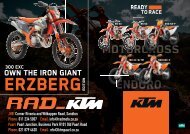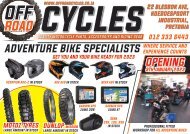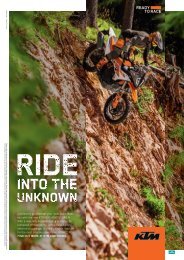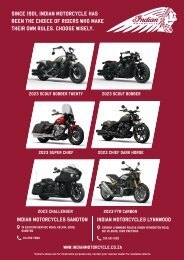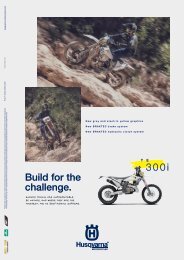RideFast May 2018
You also want an ePaper? Increase the reach of your titles
YUMPU automatically turns print PDFs into web optimized ePapers that Google loves.
The grip on offer on the wet<br />
track was really impressive.<br />
felt planted and never gave any indication it<br />
would give up. I tried carrying a bit of front<br />
brake into the bends to see how it felt –<br />
loading the front under braking – and the<br />
steering remained stable. Dabbing the back<br />
brake or trailing in hairpins never created any<br />
moments either.<br />
During the 200km road ride we were faced<br />
with many types of asphault, from gorgeous<br />
newly-laid tar to black stuff from the days of<br />
the Flinstones, and the Road 5’s felt at home<br />
on all of it.<br />
The rain in Spain, kind of.<br />
After the road ride we are treated to a nice<br />
lunch before heading to the 2nd workshop of<br />
the day, the wet course. So, while there was<br />
no rain anywhere in sight, I was keen to see<br />
how this was going to be done.<br />
We were at the Monteblanco circuit, and<br />
would be using a smaller version of the 4.5km<br />
track for the wet riding. Sprinklers were<br />
positioned at certain parts of the shortened<br />
track to help wet the tar.<br />
More grip and better water distribution is<br />
what Michelin aimed at getting out of the new<br />
Road 5. In the briefing before heading out on<br />
track, former Moto3 rider, Aleix Masbou, told<br />
us that we could get as much as 35degrees<br />
of lean angle from the new Road 5 tyre in<br />
wet conditions. A look of surprise, respect<br />
and fear greeted all our faces. Thankfully,<br />
before heading out on track and testing it for<br />
ourselves, another test rider did a few laps to<br />
show us just what needed to be done and<br />
put my mind at ease. We are also told to<br />
grab a handful of front brake, release and flick<br />
through a section highlighted by red cones.<br />
We were given two types of motorcycles to<br />
test for the wet course - Yamaha’s ultra good<br />
MT10 and the lighter, more nimble Triumph<br />
Street Triple 765 RS, which I was really<br />
excited to test for the first time.<br />
I headed out on track on the MT10 first.<br />
Turn one was slightly damp, so wasn’t that<br />
hard to commit. Turns 2, 3 and 4 were<br />
drenched so caution was the order of the day.<br />
We were only given 3 laps on each machine,<br />
and after only 1 felt really confidant in the<br />
tyre capabilities in the wet. No movement<br />
upright or leant over, the Road 5’s felt solid<br />
and stable. Jumping on the front brake hard<br />
and flicking not through the cones for the first<br />
time in anger was a lot easier than I thought,<br />
again showing off the new tyres strengths and<br />
proving that Michelin had indeed done their<br />
homework.<br />
Not wanting to waste anymore time, I<br />
quickly jumped on the new Triumph 765<br />
RS, eager to experience the new machine,<br />
and especially the new engine that will be<br />
used in the 2019 and beyond Moto2 world<br />
championships.<br />
RIDEFAST MAGAZINE MAY <strong>2018</strong> 3 5


